Monthly Archives: February 2019
7 floors of organic yield
A market cum food court is being planned in New Town
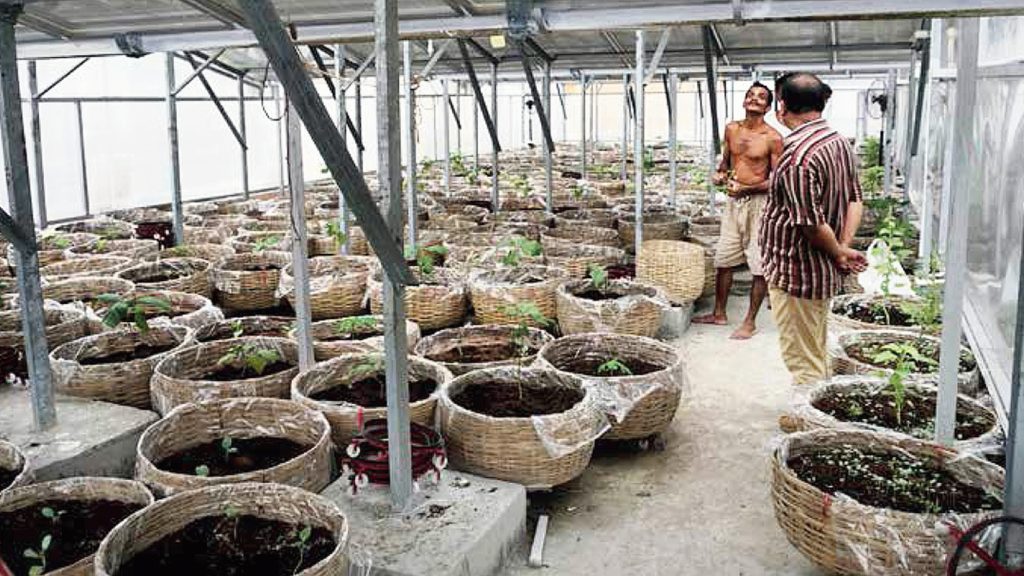
Baskets of organic vegetables on NKDA’s CB Market terrace. / The Telegraph picture
The West Bengal State Agricultural Marketing Board has tied up with the New Town Kolkata Development Authority (NKDA) to start an organic market between the Harley Davidson showroom and Eco Park. The name of the market will called Joibo Haat meaning organic market in Bengali.
Minister of the agricultural marketing department, Tapan Dasgupta, laid the foundation stone on January 17 in presence of ministers Sujit Bose and Purnendu Basu.
The plot, that has been leased from NKDA, measures around 14.77 cottahs, the building will be a G+6 one and the project should take two years to complete. The estimated cost is Rs 11.40 crore and funds are being raised from the Rashtriya Krishi Vikas Yojana.
“People are falling sick these days due to chemicals in fertilisers. Going organic is a much safer option,” Dasgupta told The Telegraph Salt Lake. “Also, we wanted to give a platform to those involved in organic farming.”
According to an official of the state agricultural marketing board, they have already called for a tender to build the market. “We expect construction to start within the next few weeks,” said the official.
Organic supermarket
The market will have separate floors for a variety of organically grown fruits, vegetables, rice, pulses, flowers and even honey. The idea is to create an organic hub in New Town. According to the officer, the organic produce will not only taste better but will also be healthier.
“We want to give a super market-like experience to shoppers who come here. Everything stocked will be organically produced with zero use of chemical fertilisers or pesticides. All racks will be properly labelled,” the official said.
Organic produce growers and self help groups from all over the state will be welcome to showcase and sell their produce too.
“The farmers’ markets organised in Calcutta get good response from both buyers and sellers so we believe there is a ready market for organic products. “Organic farming is being undertaken in large scale in North and South 24-Parganas and we’ve observed that people of New Town are ready to pay higher prices for quality products. So setting shop in New Town would guarantee more buyers,” the officer said.
The ground, first and second floors will house the organic market. The third floor will house an organic food court. The fourth floor will have training centre for skill development. The fifth floor will house an advanced laboratory and office. The sixth floor will have a guesthouse.
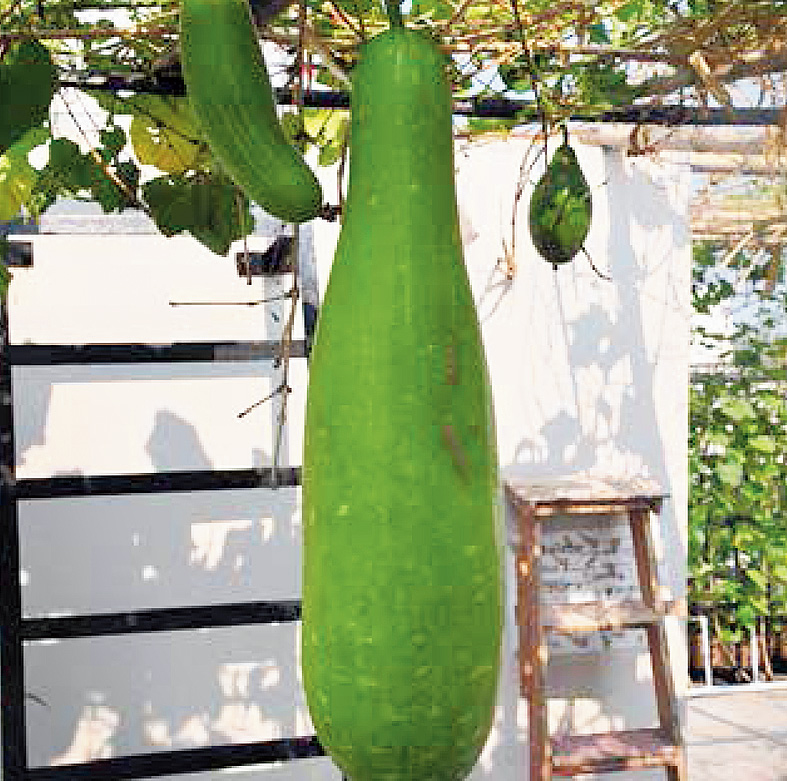
Gourds hanging from the overhead structures. / The Telegraph picture
The laboratory will not only conduct research on organic farming but also verify whether a vegetable is organic or not.
This will be the first laboratory in the state to conduct such tests. Currently, to conduct such tests samples are sent to other states. This adds to expenses.
The laboratory will also work to develop organic fertilisers and the facility will have regular workshops to encourage farmers from the villages to shift to organic methods.
Sikkim has managed to become India’s first fully organic state by implementing organic practices of farming on around 75,000 hectares of agricultural land. It had taken Sikkim around 12 years to achieve this feat and Bengal is now taking baby steps towards organic methods.
Farm on your rooftop
Debashis Sen, the chairman of NKDA, said such a market in New Town would give plenty of opportunities for residents to buy fresh produce and also motivate them to have roof-top gardens where vegetables can be grown.
“We are already in talks with agencies to develop rooftop farms on individual plots and buildings. Farming and gardening on the roof of a building will enhance the look of the terrace and provide quality food to residents. It will also keep the building cooler in summer,” said Sen.
NKDA runs a farm on the terrace of CB Market near Novotel and Sen says hydroponics and other alternative methods for container gardening are being used there extensively. This farm was started by Owl Spirit, a company formed by the NGO Uthnau, in 2017. They grew gourds, spinach, beans, cucumbers, carrots, brinjals etc in baskets up there.
At present, they are working on tower planters at Karigori Bhavan opposite Uniworld City. These are containers stacked one above the other and they are growing brinjals, chillies, gourds and spinach on trial basis there.
“We have been approached by the NKDA to help residents grow organic food in their balconies and terrace,” says director of Owl Spirit, Kunal Deb. “Chemical use in commercial crops has spread to such an extent that even if you have money today you can’t buy healthy food. It’s best if you can grow your own food then.”
Hari Mitti is another agency that has been approached. This Sector V-based company prepares crates of fruit, vegetable and herbs to sell to residents. “The nascent stages of plants are the most delicate. We shall look after the plant at this stage and hand them over when they are older and hardy. We also provide lifelong maintenance of the plants,” says Suhrid Chandra, the founder.
That there is a demand for organic farming is clear from the fact that Hari Mitti has started managing 82 rooftops over the past two years. “If a family takes in 30-35 crates, it won’t need to buy any vegetables from the market besides potatoes and onions.”
Both the agencies try to avoid using soil. Instead they use coco peat, vermin compost, hydroponics etc. “These options are lighter than soil and also, if we use soil, no matter where we source it from, it will be contaminated with chemicals,” says Chandra.
But the agencies are wary of practical problems. In 2014, Owl Spirit had started an urban farm on the terrace of Siddha Town in Rajarhat. They had to discontinue after nine months after residents refused to pay for its maintenance. “Residents can also complain about insects, those living on the top floor may complain of disturbance,” says Deb. “So we have requested minister Firhad Hakim to allow us to carry out urban farming atop government buildings.”
Residents are keen to give organic farming a shot. “I shall be retiring in six months and thereafter would love to indulge in gardening. When I moved to New Town I had about 25 pots but most of them didn’t survive. With help from these experts I would love to grow lemons, chillies and other fruits and vegetables,” says Chaita Mukherjee, a resident of Sree apartments.
Inputs from Sudeshna Banerjee
source: http://www.telegraphindia.com / The Telegraph, Online edition / Home> West Bengal / by Snehal Sengupta and Brinda Sarkar in Calcutta / February 15th, 2019
18
In Version 2.0, Kolkata’s iconic Metro cinema is a ‘filmi store’
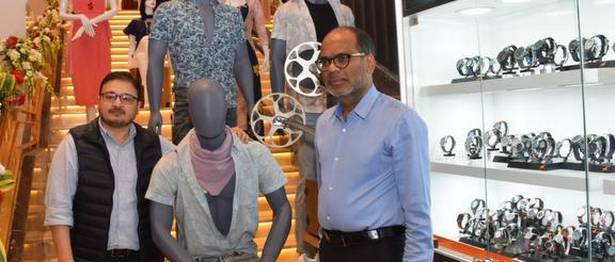
Future Lifestyle Fashions CEO Vishnu Prasad (right) and Future Retail CEO-East Zone Manish Agarwal – Debasish Bhaduri
It was in 1934 that American film production company Metro-Goldwyn-Mayer decided to set up a cinema hall in Calcutta to promote its films. The hall was inaugurated in 1935. Famous as an elite British city, the then Calcutta was a large market for Hollywood films.
Eighty-five years later, the iconic cinema hall on Chowringhee Road has made way for Future Group’s first ever movie themed ‘Central’ store.
The fashion and lifestyle retail store will play old Hollywood, Hindi and Bengali hits. These classics were big draws at the ‘Metro cinema’. The screenings are likely to start in April.
According to Vishnu Prasad, CEO, Future Lifestyle Fashions (which owns Central), the company is preparing a list of classics that have been screened. Plans are afoot to bring in the yesteryear stars who featured in these films. Over each week, a film will be played.
First thematic store
“This will be our first thematic store. In fact, Metro Central will be a filmi store. Going forward we may look to host theme-based movie screenings at the store. The idea is to bring alive a lost heritage of the city,” Prasad told BusinessLine.
Metro Central, as it is called, is expected to rake in ₹100 crore by FY20 with apparel sales accounting for nearly 70 per cent of it.
Down memory lane
Metro Cinema’s distinctive art deco structure has, over the years, defined the culture of the city. Initially, it screened only films produced by MGM. Gradually, Hollywood films made way for Hindi cinema and an occasional Bengali film.
The two-storied structure was designed by Thomas Lamb, a Scottish architect settled in the US who built several movie theatres around the world. MGM commissioned him to build two theatres in India. Metro Calcutta’s famous cousin in Mumbai was built in 1938.
Prasad points out that “special care” was taken at the time of renovation so that the art-deco façade, waterfall-style columns and grand staircase within were retained. The company has spent ₹22-25 crore on renovating the heritage structure that will have 55,000 sq ft of space.
Sources say the group had held talks for the renovation and reuse of Grace cinema, too, but issues such as structural stability of the building put things on the backburner.
source: http://www.thehindubusinessline.com / Business Line / Home> Variety / by Abhishek Law / Kolkata / February 15th, 2019
Calcutta cop lights up lives beyond Diwali
Runs a school for poor with half of his salary
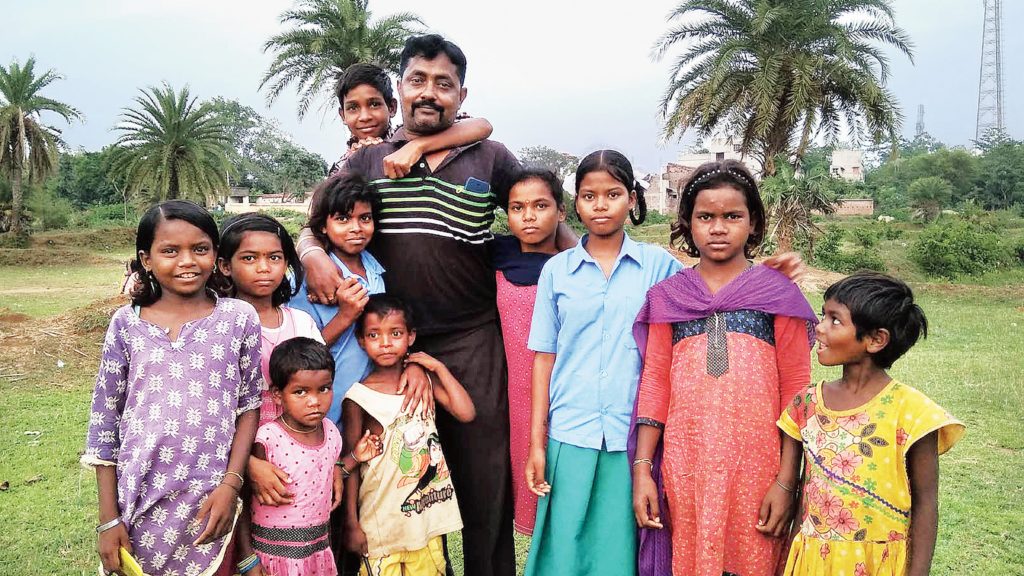
Arup Mukherjee, a constable of the South Traffic Guard, with some of the students of the school that he started with his savings in 2011 at Puncha village of Purulia district. / The Telegraph
A Calcutta police constable who as a child had made a promise to himself to help the poor now sets aside Rs 20,000 from his salary of Rs 37,000 each month to run a school for abandoned and underprivileged children.
When 43-year-old Arup Mukherjee is not managing traffic at a busy intersection, he is busy pursuing his mission to rescue and rehabilitate abandoned children and convince impoverished and unlettered parents to send their daughters and sons to school.
Some of these children were in New Alipore on Monday to inaugurate a Kali Puja, escorted by the Samaritan who works tirelessly to dispel the darkness in their lives.
Mukherjee’s zeal to rescue and educate children from the Sabar tribe of Purulia originated from a childhood curiosity about the persecution faced by a community counted among the poorest of the poor.
“I have witnessed since childhood people belonging to the Sabar tribe being blamed for theft or any other crime in the areas they inhabit. I have seen them being mistreated and ostracised and not given jobs, resulting in some resorting to crime. When I asked my grandfather about it, he told me this was because they were not educated and hence unable to find employment,” he told Metro.
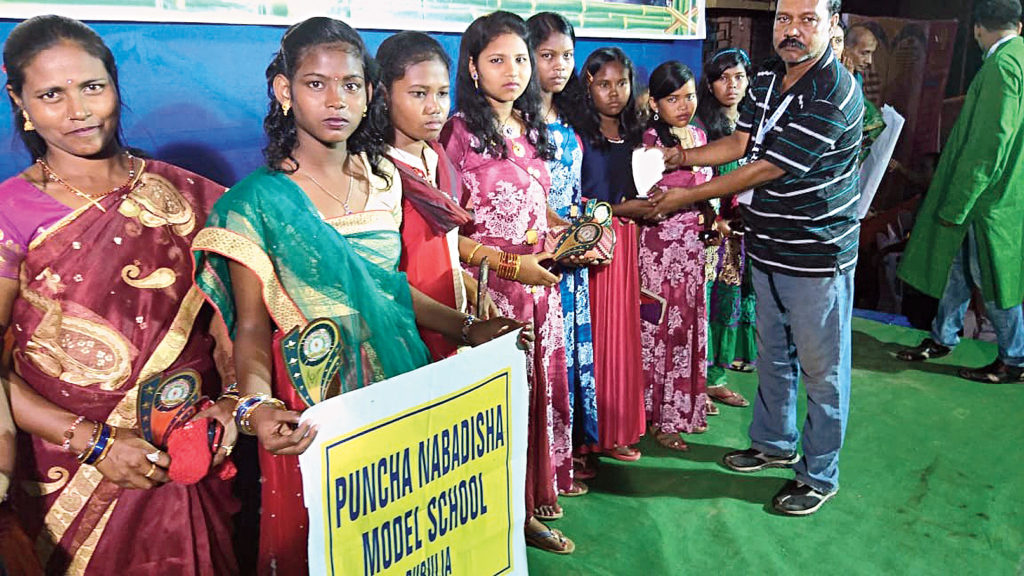
Some students of the school after inaugurating a Kali Puja in New Alipore on Monday. / The Telegraph
Mukherjee, who was six years old at the time, never forgot what his grandfather told him or the promise he had made to himself. In 1999, he joined Calcutta police and started saving immediately for what would go on to become the fuel for his existence.
Puncha Nabadisha Model School became a reality in 2011, putting this unassuming constable of the South Traffic Guard on a path few like him would dare to tread. “I remember what my grandfather told me when I had spoken to him about what I wanted to do. He asked me to grow up, start earning a living and then think of doing something for the Sabar children,” Mukherjee recalled.
The initial corpus of Rs 2.5 lakh for the school in Puncha village of Purulia district, around 280km from Calcutta, came entirely from Mukherjee’s savings. He also took a bank loan of Rs 1 lakh and another Rs 50,000 from his mother to build five rooms with an asbestos roof on a plot donated by a friend of his father.
Starting with 15 children, Puncha Nabadisha Model School has grown into an institution that provides education to 112 children aged between 4 and 15.
It wasn’t easy in the beginning for Mukherjee to convince the Sabar tribe that he wanted their good. “They started trusting me after realising I did not have any motive. I would tell them, “Send your children to study if you do not want your plight to be like yours’. That struck a chord,” he said.
An incident three years ago highlights the despair and desperation that Mukherjee occasionally encounters. “I was visiting this village in Purulia when the strong smell of kerosene hit my nose outside a tribal house. A mother had wrapped three of her children, the youngest barely a year old, in a blanket and sprinkled kerosene on them to do the unthinkable. I went into the hut and held the mother by her hand. She said her children were asking for food and she didn’t have any to feed them,” he said.
Mukherjee took the three children under his care and their mother hasn’t met them since. The eldest of the siblings is now in Class III and the second one in Class II.
According to Mukherjee, who received a special honour at The Telegraph School Awards for Excellence 2018 in August, the courage to accomplish what he does comes from being a policeman.
Many among the Sabar community depend on him not only to give their children an education but also bail them out whenever they are unfairly accused of a crime. “Someone might be innocent but how to prove it when you can’t comprehend the law? They now have the confidence to speak up because they know that if they are right, I will help them,” Mukherjee said. “Most of them no longer resort to crime to feed their families.”
Around 20,000 members of the Sabar tribe are spread across five blocks of Purulia district. The children who go to Mukherjee’s school are provided food and a place to stay in. After Class IV, schooling continues in the secondary and high schools in that area.
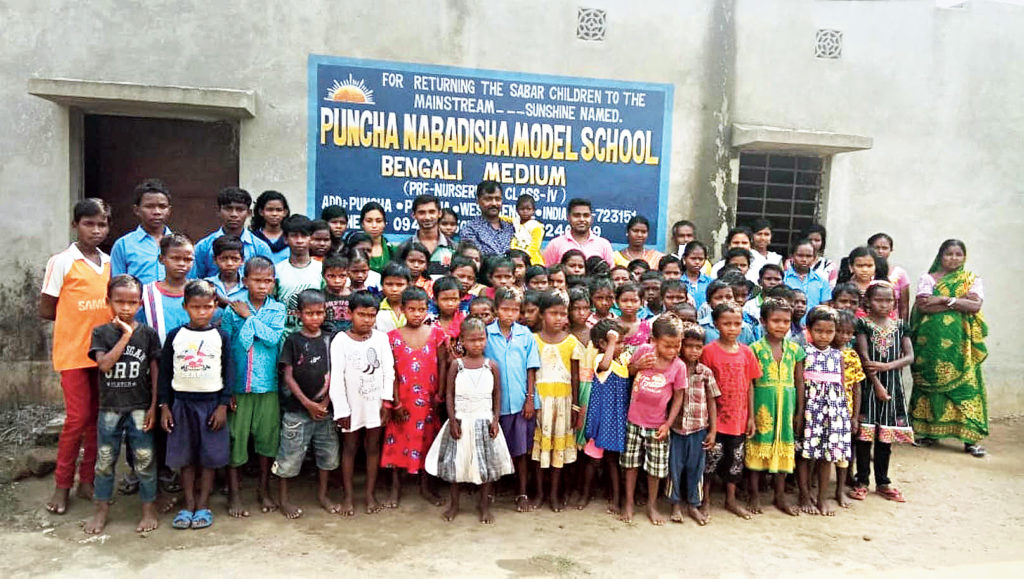
Students and staff of Puncha Nabadisha Model School outside the school building. / The Telegraph
Puncha Nabadisha Model School needs Rs 45,000-50,000 a month to function, but Mukherjee does not believe in going around with a begging bowl. He accepts only voluntary donations. “I do not want to force people to help my children, neither do I want them to think that I am collecting funds for my own needs. People see the work that is done and offer help, which I accept,” he said.
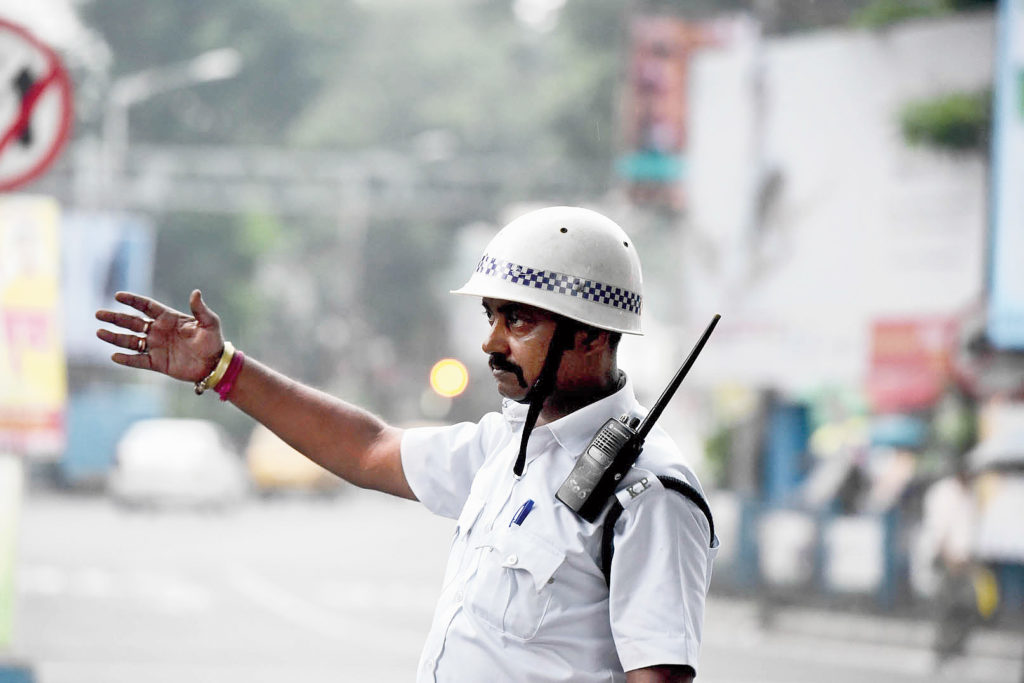
Constable Arup Mukherjee manages traffic at an intersection in the city. / The Telegraph
Mukherjee is the father of twins, both students of Class XI, but it is the responsibility of being “Baba” to his extended family of 112 children that keeps him going. “My family does not make any demands of me. They are not upset that I don’t spend my entire income on them. They are rather proud of me,” he said.
source: http://www.telegraphindia.com / The Telegraph, online edition / Home> West Bengal / by Jhinuk Mazumdar and Pranab Mondal in Calcutta / November 07th, 2018
Curtain goes up on Thunchan fete
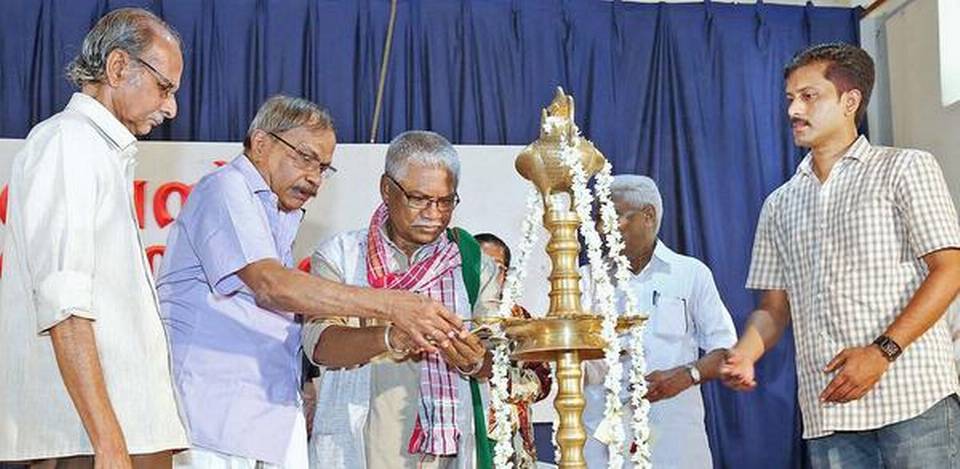
Bengali writer Manoranjan Byapari inaugurating the Thunchan Literary Festival at Thunchan Paramba, Tirur, on Friday.
This year’s Thunchan Literary Festival began at Thunchan Paramba, Tirur, on Friday. Inaugurating the festival, well-known Bengali writer Manoranjan Byapari described his life’s journey from being a shepherd to accidentally meeting Jnanpith laureate Mahasweta Devi while riding an autorickshaw.
He said that he had entered into writing much later in life. It was his incarceration that helped him find an interest in reading books. His writings in Bengali are considered one of the strongest in Indian Dalit literature.
Thunchan Memorial Trust chairman and Jnanpith laureate M.T. Vasudevan Nair presided over the function.
Arts festival
Mr. Nair released the Thunchan history penned by K. Sreekumar by giving a copy to Artist Namboothiri. Mr. Namboothiri inaugurated a book festival being held as part of the literary festival.
Poet V. Madhusoodanan Nair delivered the Thunchan Memorial Lecture on poetry and tradition. Writers Chathanath Achuthanunni, Manambur Rajanbabu, and V. Appu Master spoke.
Actor V.K. Sreeraman inaugurated the Thunchan Arts Festival.
Poet Alankode Leelakrishnan spoke.
source: http://www.thehindu.com / The Hindu / Home> News> States> Kerala / by Staff Reporter / Malappuram – February 15th, 2019
14
13
Tagore’s Visva-Bharati is restoring its 3 Japanese gardens
Expert coming from Japan today to help with the gardens, one of which was set up by the poet’s son
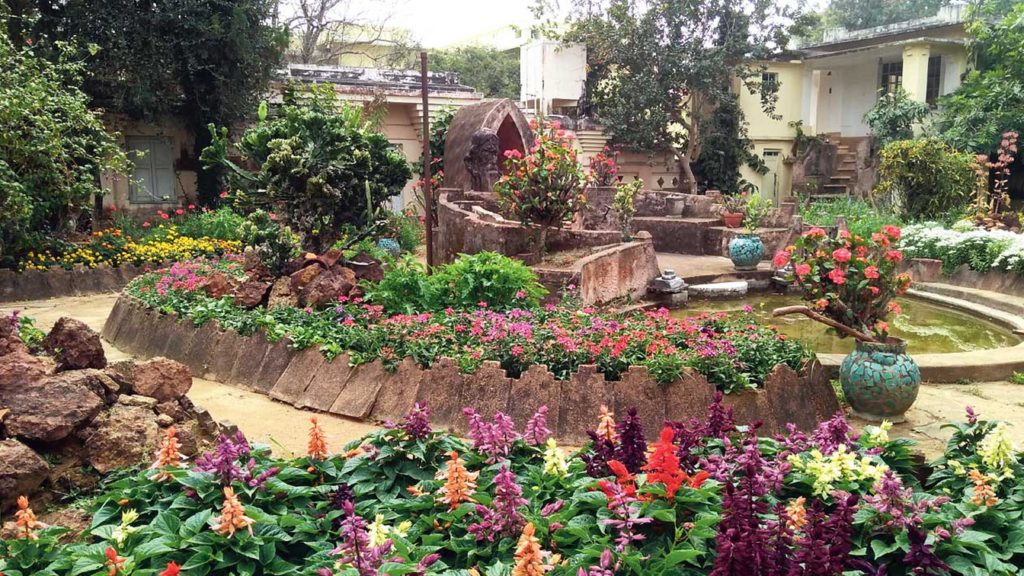
The Japanese garden next to Udayan house at Visva-Bharati.Picture by Indrajit Roy
Picture by Indrajit Roy
Visva-Bharati has decided to restore three Japanese gardens on the campus — one of them set up by Rabindranath Tagore’s son, Rathindranath — by an expert from Japan soon.
The Japanese department of Visva-Bharati has appealed to the consul general of Japan in Calcutta, Masayuki Taga, to arrange for an expert gardener who can help the university restore the gardens in keeping with Japanese culture.
Gita A Keeni, the head of Japanese department, told The Telegraph: “We wanted to restore our Japanese gardens but we had no expert gardener. So, we requested the consul general of Japan in Calcutta who has helped us get the expert. The expert in Japanese garden, Fumio Thukamoto, will visit the campus on February 11 for two days.”
Visva-Bharati sources said there were three Japanese gardens on the campus — one is beside Udayan house in Uttarayan complex, the second garden is at Nippon Bhavana and third near the Nandan gallery of Kala Bhavana.
The Japanese garden beside Udayan, where the poet stayed for a log period of time, was designed by Rathindranath Tagore in the 1930s. The gardens at Nippon Bhavana was designed by the then Japanese language professor Saini Makino and the garden near Nandan gallery was designed by a group of scholars from Japan.
Nilanjan Banerjee, the special officer of Rabindra Bhavana and a scholar in the Japanese department, said: “We did not get any expert on Japanese gardens earlier. As a result, the gardens were not being restored for a long time. The oldest Japanese garden is in the Uttarayan complex. We are happy as now the gardens will be restored properly under guidance of an expert gardener.”
Rabindranath went to Japan five times between 1916 and 1929 and saw the culture and rituals of Japan, including the concept of gardening in that country.
In his travelogue, Japan Jatri, Tagore wrote: “The Japanese know what a garden should be. Merely piling up earth and planting shrubs in geometrical patterns is not enough as you will know if you have ever been to a Japanese garden.”
Visva-Bharati sources said during his maiden visit to Japan, the poet had stayed at a beautiful garden-house, which was the residence of a Japanese silk merchant and art lover Tomitaro Hara.
“Tagore was so influenced by the culture and gardens, the Ikebana (Japanese art of flower arrangement) and the Chado (Japanese tea ceremony) that he had wished to bring an entire Japanese house to Santiniketan,” said Banerjee, the special officer of Rabindra Bhavana.
source: http://www.telegraphindia.com / The Telegraph, online editon / by Snehamoy Chakraborty in Shantiniketan / February 11th, 2019
Minto stops at ancestor’s home
A flesh-and-blood Minto and his wife were in Calcutta on Saturday, retracing the steps of his ancestors who lived here over a century ago
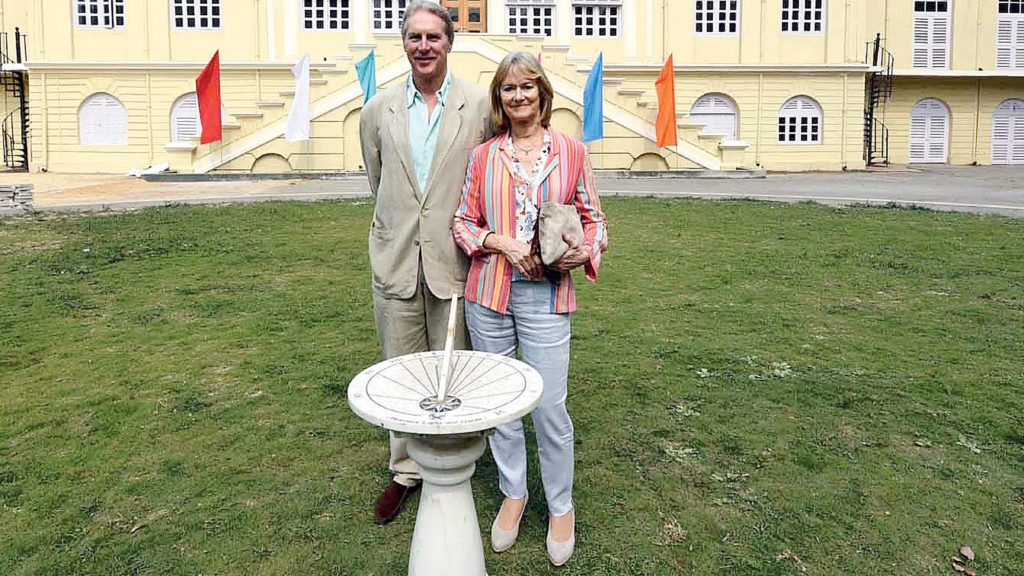
Gilbert Timothy George Lariston Elliot-Murray-Kynynmound, the seventh Earl of Minto, with his wife Diana Barbara Trafford in front of the Old Government House in Barrackpore on Saturday. / Pradip Sanyal
Minto, to most Calcuttans, is a bus stop scrawled in black on an yellow band across the sides of ramshackle minibuses. For some, it is the patch of green in front of Belle Vue Clinic named after the governor general of India.
But a flesh-and-blood Minto and his wife were in Calcutta on Saturday, retracing the steps of his ancestors who lived here over a century ago.
Gilbert Timothy George Lariston Elliot-Murray-Kynynmound, the seventh Earl of Minto, visited the summer residence of the governors general of India where the first Earl of Minto (governor general of India, 1807-1813) and the fourth Earl of Minto (governor general and viceroy of India, 1905-1910) are said to have spent many a happy weekend, “arriving on Fridays and leaving only on Monday mornings”.
“I can absolutely see why they built the summer residence right next to the river. It gives a real atmosphere of India, and I just spent a magical time there,” Minto told Metro after touring the Old Government House in Barrackpore.
“The entire purpose of this time was to visit Calcutta,” said Minto, on his second visit to India but “the very first to Calcutta”. He is scheduled to travel to Goa and Hyderabad before leaving for London.
Minto’s earlier stops in the city included Victoria Memorial Hall and the Raj Bhavan, where he saw a photograph of Lord Minto’s appointment as governor general in 1807.
“There was a lot of talk about India at home and the country was remembered with much affection,” said the current Lord Minto, pausing before his ancestor’s statue on horseback at Latbagan. “My great grandparents made many good friends in India and were in touch with them all their lives.”
With Minto on this trip are his wife Diana Barbara Trafford and author and family friend Anabel Loyd.
“The Government House designed by Captain Thomas Anbury in 1813 was used as a country residence for the British Governor-Generals,” according to the British Library online gallery.
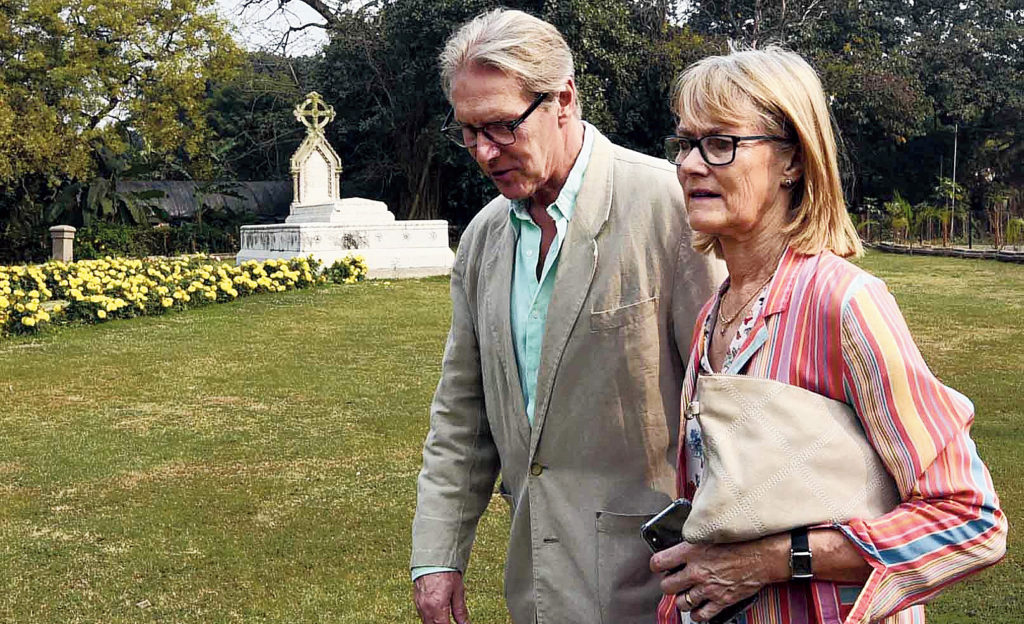
Lord and Lady Minto at (in the background) Lady Canning’s tomb. / Pradip Sanyal
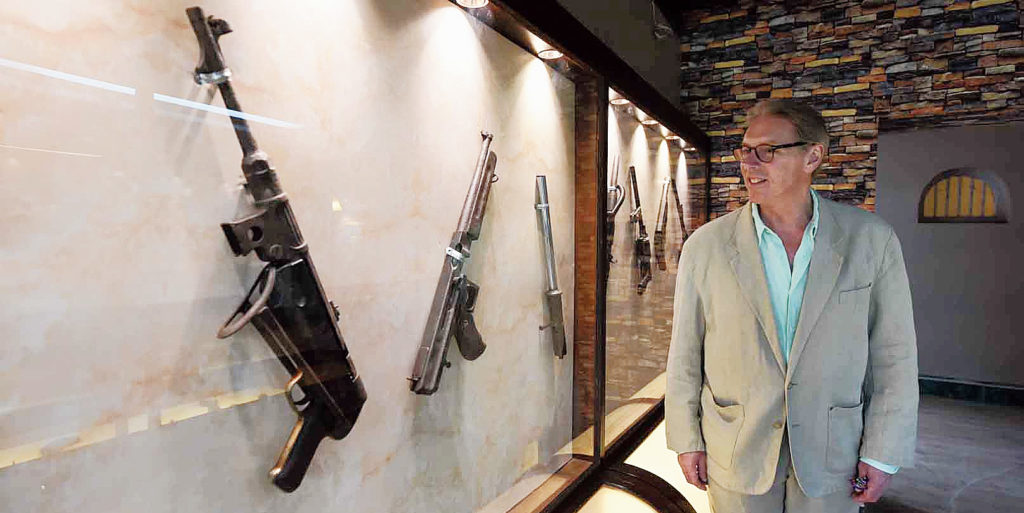
The present Lord Minto in the Westside Gallery where seized arms from the pre-and post-Independence era are displayed. / Pradip Sanyal
Lord Wellesley, who took over the commander-in-chief’s residence in 1801 in Barrackpore, commenced the building of a summer residence for the future governors general of India. He got the gardens landscaped in “English style” and added an aviary and a menagerie, both of which are in a shambles. However, only the first storey was built before Wellesley was recalled to England.
Wellesley’s dream house was added to and expanded in bits and parts by the governors general who lived there. Sir George Barlow, acting governor general, converted each corner of the verandah into a small room. In 1814-15, the building was expanded by the Marquis of Hastings who added a new storey, side wings, a portico and the Upper Entrance Hall. Lord Auckland (1835-1842) added the balcony on the western side, Lord Lytton (1876-1880) replaced the unseemly iron staircase on the southern front, Lord Ripon (1886-1884) installed a wooden porch in front while Lord Minto (1905-1910) electrified the building, laid the floor in the drawing room and redecorated the house.
The house was taken over by the Bengal government and turned into a police academy and police hospital in 1948. The hospital was later shifted out.
The current renovation and conservation of Old Government House, now Swami Vivekananda State Police Academy, has been undertaken at the initiative of Soumen Mitra, the additional director-general of police (training). “Work is on, it will take a long time to finish,” said Mitra, as he took the Mintos around.
Strolling through the lofty rooms, both the Lord and the Lady marvelled at the architecture and the ventilators that naturally cooled the rooms with the river breeze passing through the shafts and lofty windows. They were accompanied by G.M. Kapur of Intach.
Barrackpore, a cantonment area, was built at the bend of the Hooghly river, 20km north of Calcutta, and offered a splendid vista, making it the perfect “weekend retreat”.
The couple from Minto, Roxburghshire, also stopped by the Minto Fountain, a marble fountain added to the sprawling acres by Lord Minto. “The fountain was designed by Lady Minto who inaugurated it before leaving for England in 1910,” said Mitra, who found it dysfunctional and buried under a pile of rubbish.
The Mintos were taken to Flagstaff House, the current residence of the Governor. They strolled around the garden, peered at the old lighthouse, stood before Fourth Earl of Minto’s statue, inspected a series of Raj statues shifted from Calcutta to the statuary and stopped at the restored cenotaph built by the First Earl of Minto in commemoration of officers who fell in the battles of Java and Mauritius and Gwalior.
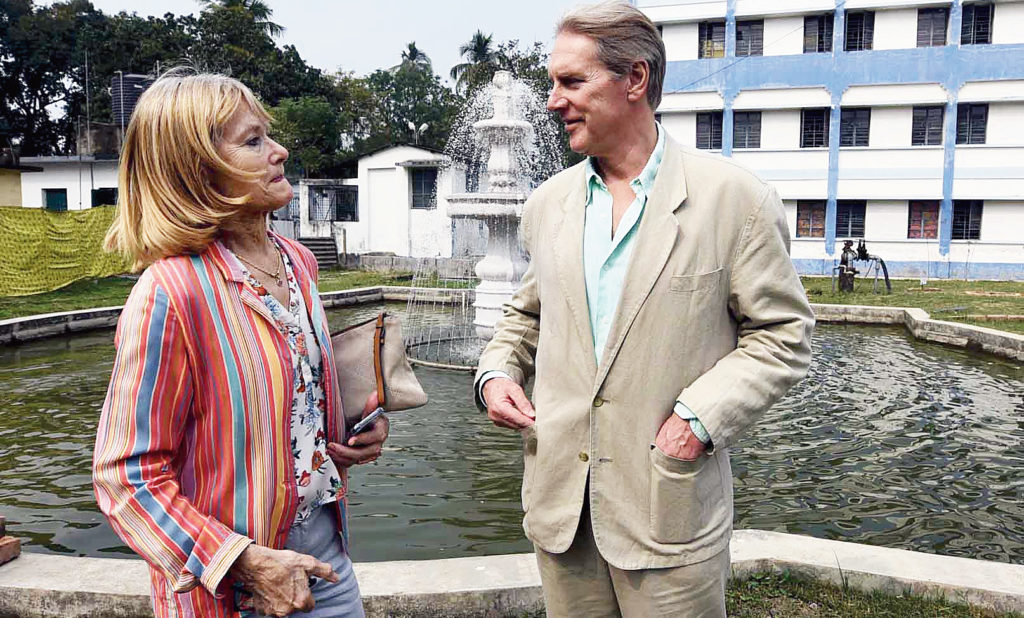
In front of Minto fountain, which was designed by Lady Minto and inaugurated by her before she left for England. / Pradip Sanyal
source: http://www.telegraphindia.com / The Telegraph, Online edition / Home> People / by Anasuya Basu in Calcutta / February 10th, 2019